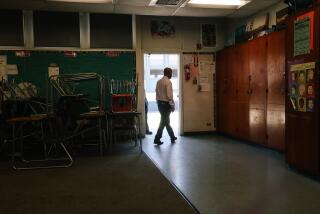Wilson Urges Online Plan for Schools
- Share via
SACRAMENTO — Gov. Pete Wilson proposed a $1-billion education initiative Monday designed to improve California’s dismal rank near the bottom of states in providing computer access to public school students.
Wilson’s plan, financed half by the state and half by local school districts, would reach all 1.6 million California high school students with computer training and access to the global Internet by 2001--providing at least one computer for every four high school students.
The proposal was politely welcomed Monday by school administrators and lawmakers. But it also is expected to set off a major debate in the upcoming Legislative session because many consider the funding--which starts with just $50 million the first year--a bare-bones starting point for the upgrade they believe is needed.
“Today, computers are as much an educational mainstay as chalkboards and textbooks,” Wilson said during an appearance Monday morning at a computer classroom in suburban Sacramento. “Every high school student in California deserves the same access to this technology--to go online and get in line with the global competition of the 21st century.”
*
California ranks 45th in the country for providing students with access to computers--up from 50th just last year, officials said. Last spring, an education task force reported that there are about 73 California students for every computer that is not obsolete.
Wilson’s proposal seeks at least 400,000 computers so that--at the high school level--there will be one for every four students. Part of the debate will focus on the need to place computers in elementary grades, which state School Supt. Delaine Eastin has recommended.
“It’s like learning a foreign language--if you wait until you’re in high school you’re not going to do it as well as if you learned it younger,” Eastin said. “This is a positive step in the right direction. Clearly it is not everything we had asked for.”
Last spring, a task force appointed by Eastin recommended the state designate $7 billion over four years to bring computers into every state classroom. She suggested that about $670 million be included in the 1997-98 fiscal year budget that Wilson is set to propose Thursday.
But Wilson said his budget proposal will be limited to a $50-million state contribution in the next fiscal year, with the remaining $450 million promised in the subsequent three years. Local school districts would be responsible for generating another $500 million over four years, which they might get from donations, bonds or general funds.
A Wilson aide said the governor did not propose more than $50 million in state money for the first year because schools are not yet prepared to spend it.
“Throwing money at something as challenging as this technology is not the best way to allow schools to come online,” said Wilson press secretary Sean Walsh. “This is an inverted pyramid to allow some schools to take advantage of it and then other schools to use those as their model.”
The proposals from Wilson and Eastin represent the maximum and minimum proposals recommended for California schools so far.
Eastin’s plan would pay for every school classroom and every grade to purchase computers, train teachers, provide new power and communications wiring, design software and pay monthly Internet subscription costs. Wilson’s is largely limited to acquiring hardware--mostly donated or refurbished machines--for high school students only.
*
“I commend the governor for using the the money to make a surgical strike at equipping at least a portion of the state’s population,” said Barbara O’Connor, co-chair of the Eastin task force. “I think he acknowledges the acute need in California. And clearly high school is the place if you want to make a real effort at providing the school-to-work link.”
In the Legislature, Democrats said they might support a plan that requires local school districts to match state funding. But they also called on the state to make a larger commitment than Wilson proposed.
Assemblywoman Kerry Mazzoni (D-San Rafael), chairwoman of the Assembly Education Committee, said she was concerned that the governor did not include money for teacher training and other related computer costs.
She predicted that the Legislature--now controlled by Democrats--will pass more funding for computerization than the governor proposed. She also said she may recommend that the state turn to voters for the money through a school bond.
Wilson has already recommended a $2-billion school bond on the June 1998 ballot to pay for construction necessary to expand his program to reduce the sizes of elementary grade classes. Mazzoni suggested the bond could be increased to $5 billion to cover the computerization effort as well.
Wilson’s proposal--as well as the suggestions from Eastin--are made possible by the state’s surging economy and a windfall budget surplus, the result of higher-than-expected tax revenues.
State law requires about 60% of that surplus to be spent on public schools--a formula decided in 1988 by voters with Proposition 98. Wilson’s announcement represents his proposal to the Legislature about how the money should be spent.
Last week, the governor said he will add an additional $488 million in his upcoming budget to extend his program to reduce class sizes all the way from kindergarten through third grade.
Wilson’s budget proposal will also include $10 million to help computer donation programs such as the Detwiler Foundation, which had a representative at the governor’s announcement Monday.
Wilson included a similar amount in last year’s budget plan, which Detwiler officials said they used to help refurbish used computers donated by industry.
But many of the aging computers are not capable of processing the data needed for graphics or technologies such as CD-ROM.
Times education writer Richard Lee Colvin contributed to this story.
More to Read
Sign up for Essential California
The most important California stories and recommendations in your inbox every morning.
You may occasionally receive promotional content from the Los Angeles Times.










